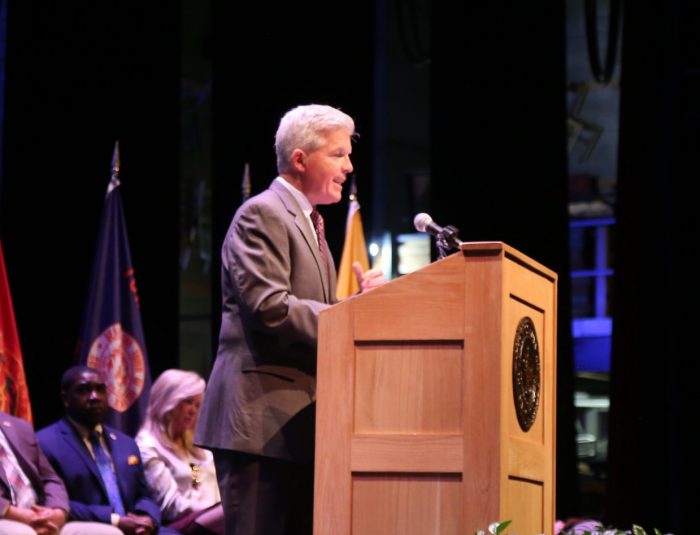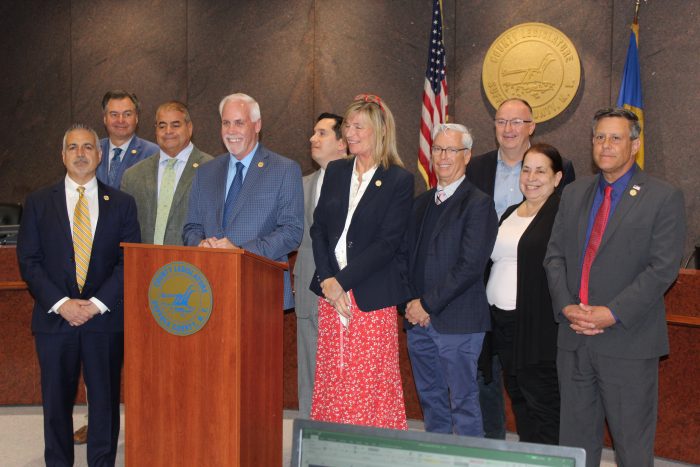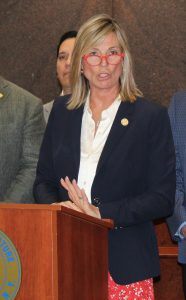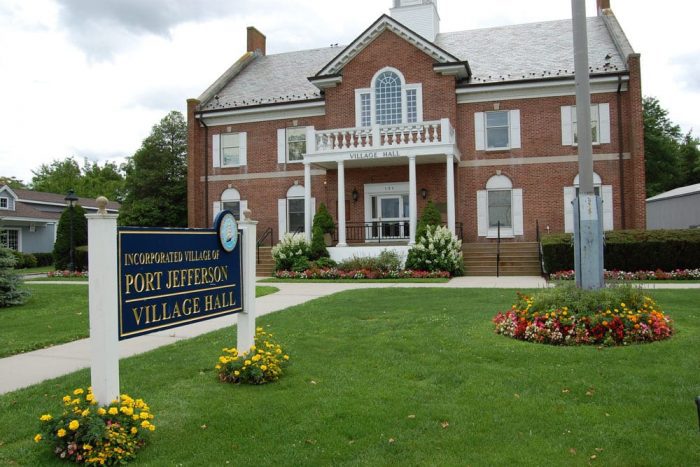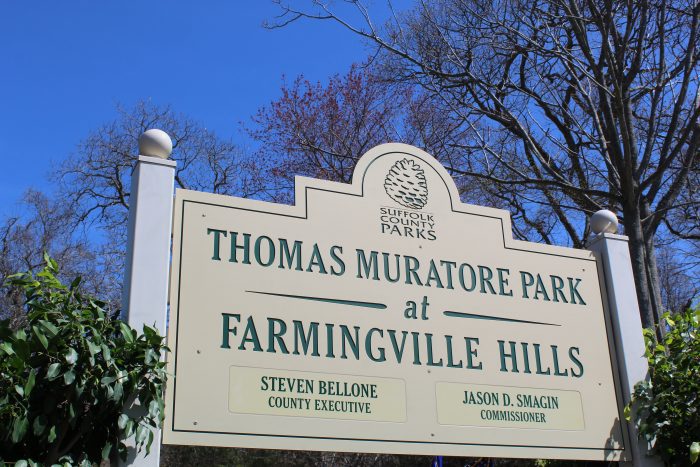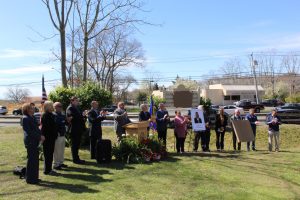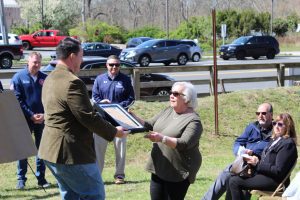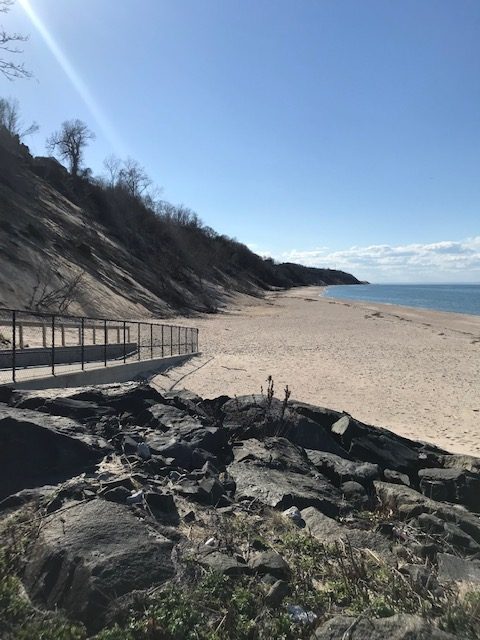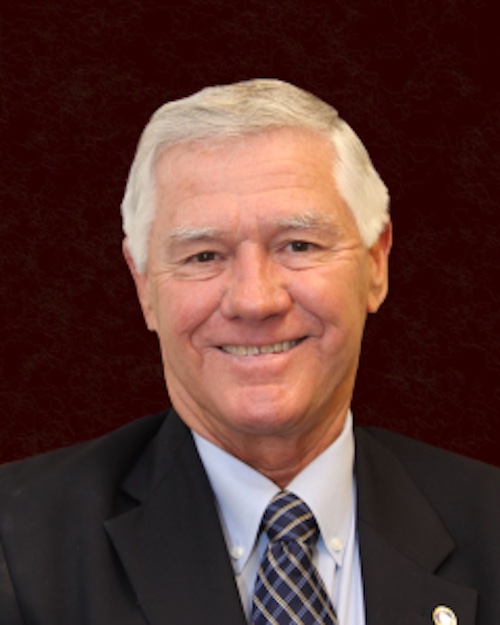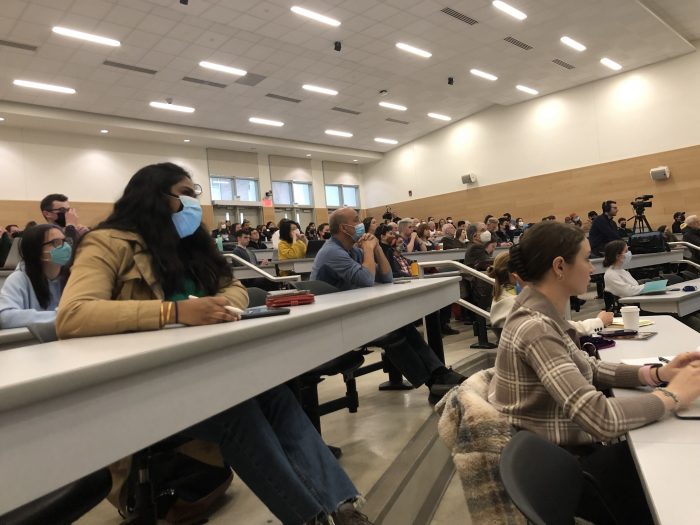By Raymond Janis
At the Shea Theatre, Suffolk County Community College Ammerman campus, County Executive Steve Bellone (D) delivered his State of the County address May 18.
The county executive started his speech with a moment of silence to honor the lives lost in the Buffalo gun tragedy.
“We continue to grieve for those who were lost, for the Buffalo community and, most importantly, for the families that have been directly impacted by this incomprehensible act of hate,” he said. “We must speak out against hateful rhetoric that is contrary to the American creed and stand up for what we do believe. This requires that we continue to celebrate our diversity here and recognize it for what it is — a strength.”

COVID-19 recovery
The county executive acknowledged the many challenges of leading the administration through the public health crisis caused by the COVID-19 pandemic. “In March of 2020, life as we knew it shut down,” he said. “The world came to a halt and Suffolk County was at the epicenter of the COVID-19 global pandemic in our state and in our nation.”
Bellone reported that the county has lost over 4,400 residents to the virus. As normalcy slowly returns, he said that the pandemic has taught valuable lessons.
“One of the clearest takeaways for me is the importance of public service,” he said. “During this county’s darkest hour, our employees did it all. While much of the rest of the world was on lockdown, county employees ensured critical operations did not stop.” He added, “It is fitting that this year’s State of the County is here at Suffolk County Community College’s Ammerman campus as this was the location for one of our first mass-vaccination sites.”
Human resources
One of Bellone’s points of emphasis during the address was the need for greater human resources personnel in county government. Despite its size, Bellone said that the county government still operates without a fully functional human resources department.
“Human resources, to the extent that it has existed in this government, has been done on an ad hoc basis,” the county executive said. “Commissioners or department heads who are not human resource professionals perform these functions when a problem occurs or a crisis arises.”
Bellone considers this no way to run an organization, especially one as large and impactful to the lives of residents as the Suffolk County government. He likened human resources to military supply units.
“Operating departments without effective human resources is like the military trying to operate without its supply units,” he said, adding, “You can have the best fighting force in the world, but if those support units are ineffective, the mission will be undermined.”
Through the addition of the latest HR software and new organizational practices, he suggested the county can save $18 million per year in payroll operation costs alone.
Investing in the future
The county executive called the Long Island Rail Road a critical asset. “Nearly two centuries after its tracks were laid, that initial investment is still reaping extraordinary returns for the region,” he said.
Bellone said the county is taking two significant leaps forward with both the East Side Access and Third Track projects.
The county executive announced a new project called the Midway Crossing, which proposes to create two new public facilities which have long been under consideration: the Long Island Convention Center and a north terminal at MacArthur Airport.
“It is crazy that a region of our size and significance, of nearly 3 million people, with incredible innovation and natural assets, adjacent to the largest and most important city in the nation, has no convention center,” he said. “A convention center would bring thousands of people and businesses to our region every year from other parts of the country, importantly bringing new dollars into our local economy.”
In a grand plan, Bellone envisions this convention center will be connected to both a new state-of-the-art north airport terminal at MacArthur Airport and to the main line of the LIRR.
“The convention center attendees would conveniently and easily fly in and out of MacArthur Airport, and if a flight wasn’t available they would still have the ability to take the train from either JFK or LaGuardia,” he said. “Every great region must have a great regional airport and no one can deny that Long Island is one of the great regions in the nation.”
Bellone also foresees other opportunities to integrate the regional economy along the Ronkonkoma Branch line of the LIRR. He proposes relocating the “wholly underutilized” Yaphank station to create the Brookhaven National Laboratory Station, “effectively connecting this global institution to MacArthur Airport and the larger innovation ecosystem in the region by mass transit.”
Environmental quality

The county executive highlighted some of the environmental initiatives that his administration is working on. He said this region is currently on the front lines of the battle against climate change.
“As an island, we know that we are on the front lines of climate change,” Bellone said. “By taking action, we are not only helping to protect our region in the future, but we are creating economic opportunities in the near term as well.”
He also discussed the need for more charging stations as drivers throughout the county continue to transition to electric vehicles. He announced that two-dozen public libraries in each of the 10 towns in the county have partnered with the administration in the development of a charge-sharing network.
Suffolk County has also emerged as one of the centers of the offshore wind industry in the region, according to Bellone. “This is an industry that will have a more than $12 billion economic impact on New York,” he said. “Suffolk County is well positioned to benefit from the new supply chains and the creation of approximately 7,000 new jobs.”
The county has also reached out to businesses and collaborated with local colleges to establish workforce training programs that will prepare residents for these new jobs.
Opioid crisis
Exacerbated by the pandemic, ending the opioid epidemic remains near the top of Bellone’s list of priorities. He said opioids have wreaked havoc upon the county, causing horrific damage for users and their families.
“After years of steady progress, the pandemic created unprecedented circumstances of fear, isolation and anxiety that led to an increase in overdoses — 374 confirmed [fatal] cases last year alone,” he said.
The Greatest Generation“If we want to be part of the solution, then we need to do what the Greatest Generation did: Put our heads down and build. Build our families first and then do our part to build stronger communities.” — Steve Bellone
Bellone concluded his address on a positive note. With war again raging in Europe, the county executive reminded the audience of the example of the Greatest Generation.
“The attack on Ukraine is the kind of naked aggression against a sovereign nation in Europe that we have not witnessed since the end of World War II,” he said. “The images and the videos that we see coming out of Ukraine are absolutely devastating and heartbreaking.” He added, “I don’t think that it is any coincidence that after more than 75 years of peace in Europe, forged by the sacrifices of American veterans, that we’re seeing this kind of aggression happen just as this Greatest Generation slowly, but inevitably, fades into history.”
Bellone said it is important to honor the legacy of the Greatest Generation as these Americans had laid the foundation for a future of peace. “They won the war and then they came home and built a better future for all of us,” he said. “If we want to be part of the solution, then we need to do what the Greatest Generation did: Put our heads down and build. Build our families first and then do our part to build stronger communities.”

